Type Deep Tube Stations 50 Website tfl.gov.uk | Colour on map Black | |
 | ||
Ridership 252.310 million passenger journeys (2011/12) | ||
Secrets of the northern line
The Northern line is a London Underground line, coloured black on the Tube map. The section between Stockwell and Borough opened in 1890, and is the oldest section of deep-level tube line on the network.
Contents
- Secrets of the northern line
- Full journey on the northern line from morden to high barnet via charing cross ato
- Formation
- Integration
- Extensions
- Edgware Extension
- Morden Extension
- Naming
- Great Northern City Railway
- Northern Heights plan
- Intended service levels
- Progress of works
- Recent developments
- 24 hour weekend service
- Services
- Permanently closed stations
- Resited stations
- Abandoned plans
- Rolling stock
- Tunnels
- Depots
- Future
- In popular culture
- References
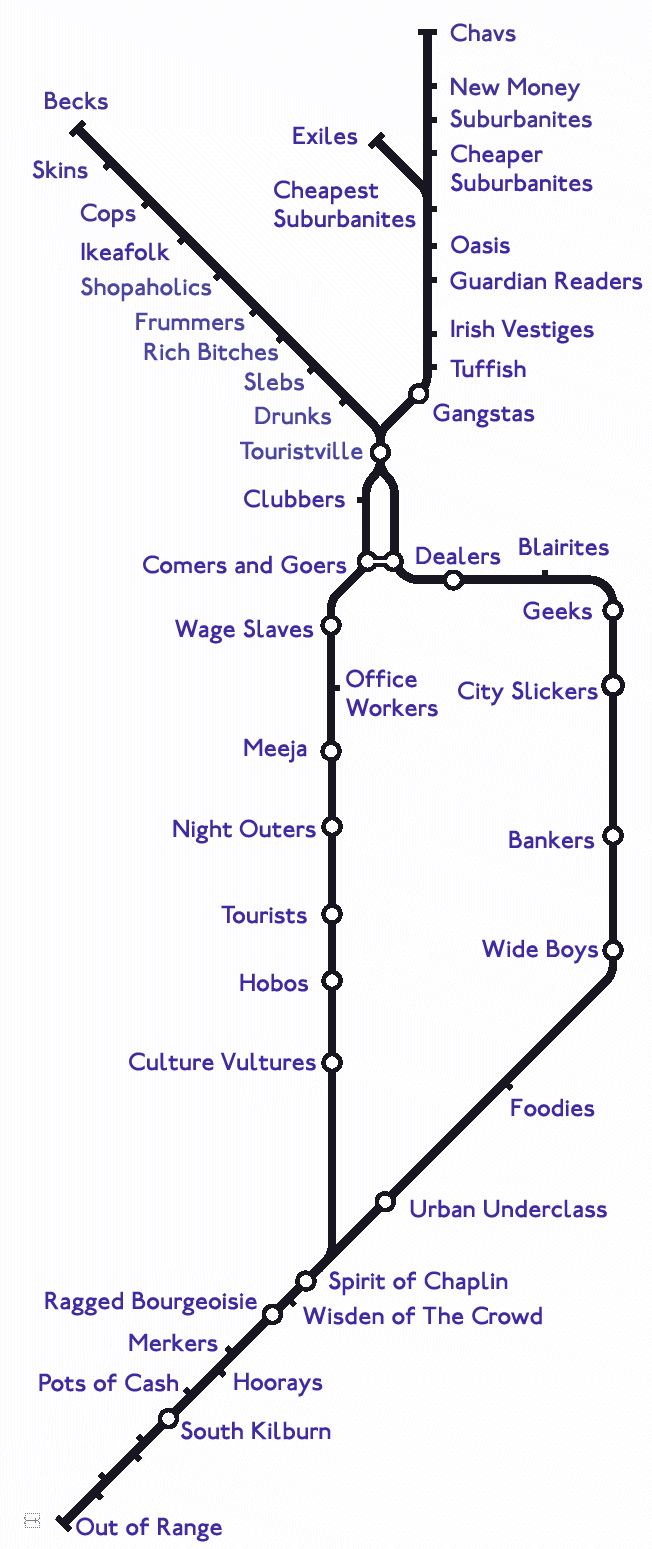
For most of its length it is a deep-level tube line. There were about 252,310,000 passenger journeys in 2011/12 on the Northern line, making it the second-busiest line on the Underground. (It was the busiest from 2003 to 2010.) It is unique in having two different routes through central London – the Charing Cross or West End branch, serving the central part of zone 1, and the Bank or City branch, serving the eastern part of that zone. Despite its name, it does not serve the northernmost stations on the network, though it does serve the southernmost station (Morden), as well as 16 of the system's 29 stations south of the River Thames. There are 50 stations on the line, of which 36 have platforms below ground.
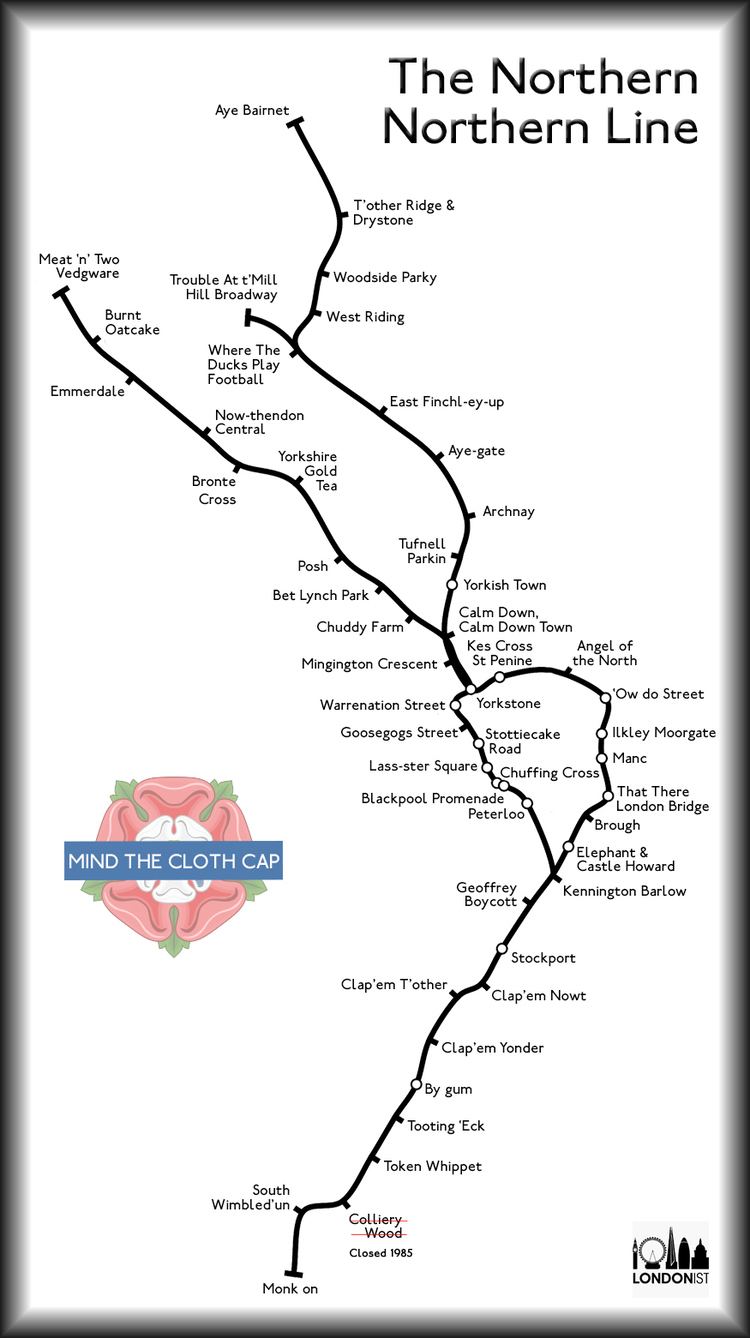
The line has a complicated history, and the current complex arrangement of two northern branches, two central branches and the southern branch reflects its genesis as three separate railway companies, combined in the 1920s and 1930s. An extension in the 1920s used a route originally planned by a fourth company. Abandoned plans from the 1920s to extend the line further southwards, and then northwards in the 1930s, would have incorporated parts of the routes of two further companies. From the 1930s to the 1970s, the tracks of a seventh company were also managed as a branch of the Northern line. An extension from Kennington to Battersea is now under construction, which may either give the line a second southern branch to go with its two northern and central branches, or may see the line split into two distinct lines with their own identities.
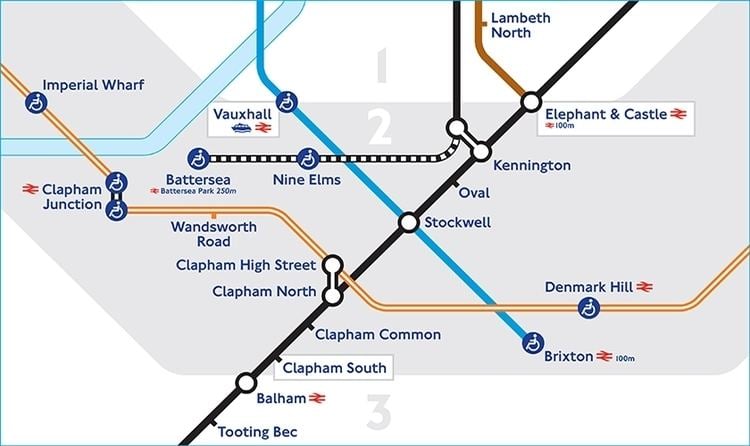
Full journey on the northern line from morden to high barnet via charing cross ato
Formation
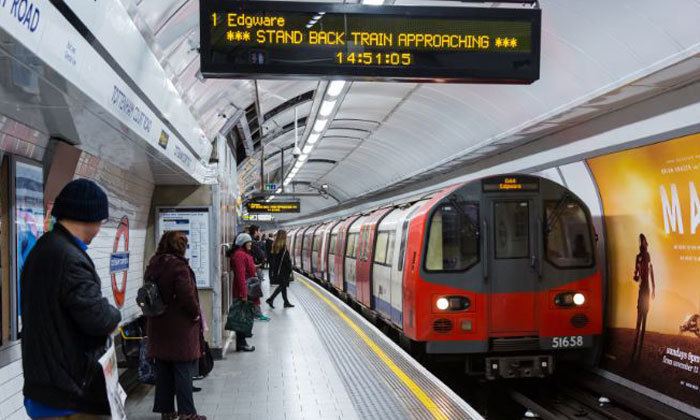
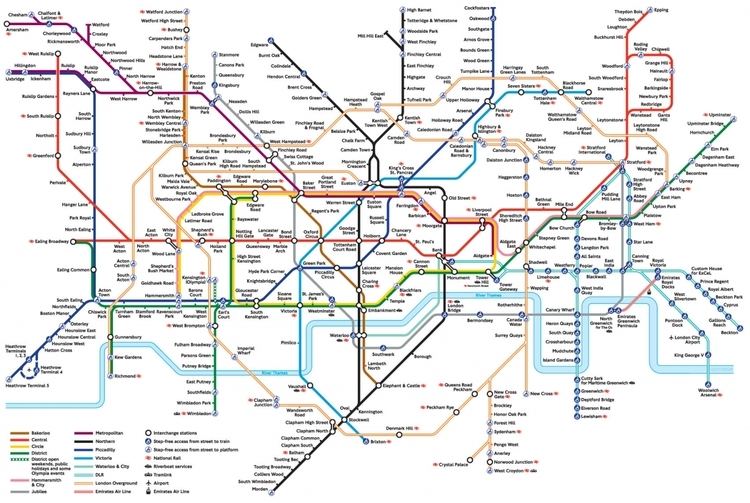
The core of the Northern line evolved from two railway companies: the City & South London Railway (C&SLR) and the Charing Cross, Euston & Hampstead Railway (CCE&HR).
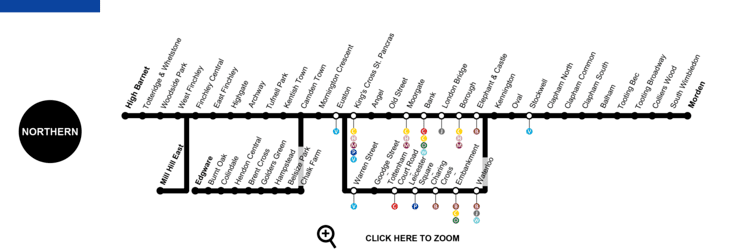
The C&SLR, London's first deep-level tube railway, was built under the supervision of James Henry Greathead, who had been responsible, with Peter W. Barlow, for the Tower Subway. It was the first of the Underground's lines to be constructed by boring deep below the surface and the first to be operated by electric traction. The railway opened in November 1890 from Stockwell to a now-disused station at King William Street. This was inconveniently placed and unable to cope with the company's traffic so, in 1900, a new route to Moorgate via Bank was opened. By 1907 the C&SLR had been further extended at both ends to run from Clapham Common to Euston.

The CCE&HR (commonly known as the "Hampstead Tube") was opened in 1907 and ran from Charing Cross (known for many years as Strand) via Euston and Camden Town (where there was a junction) to Golders Green and Highgate (now known as Archway). It was extended south by one stop to Embankment in 1914 to form an interchange with the Bakerloo and District lines. In 1913 the Underground Electric Railways Company of London (UERL), owner of the CCE&HR, took over the C&SLR, although they remained separate companies.
Integration
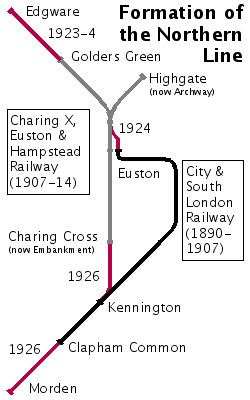
During the early 1920s, a series of works was carried out to connect the C&SLR and CCE&HR tunnels to enable an integrated service to be operated. The first of these new tunnels, between the C&SLR's Euston station and the CCE&HR's station at Camden Town, had originally been planned in 1912 but had been delayed by World War I. The second connection linked the CCE&HR's Embankment and C&SLR's Kennington stations and provided a new intermediate station at Waterloo to connect to the main line station there and the Bakerloo line. The smaller-diameter tunnels of the C&SLR were expanded to match the standard diameter of the CCE&HR and the other deep Tube Lines.
Extensions
In conjunction with the works to integrate the two lines, two major extensions were undertaken: northwards to Edgware in Middlesex (now in the London Borough of Barnet) and southwards to Morden in Surrey (then in the Merton and Morden Urban District, but now in the London Borough of Merton).
Edgware Extension
The Edgware extension used plans dating back to 1901 for the Edgware and Hampstead Railway (E&HR) which the UERL had taken over in 1912. It extended the CCE&HR line from its terminus at Golders Green to Edgware in two stages: to Hendon Central in 1923 and to Edgware in 1924. The line crossed open countryside and ran on the surface, apart from a short tunnel north of Hendon Central. Five new stations were built to pavilion-style designs by Stanley Heaps, head of the Underground's Architects Office, stimulating the rapid northward expansion of suburban developments in the following years.
Morden Extension
The engineering of the Morden extension of the C&SLR from Clapham Common to Morden was more demanding, running in tunnels to a point just north of Morden station, which was constructed in a cutting. The line then runs under the wide station forecourt and public road outside the station, to the depot. The extension was initially planned to continue to Sutton over part of the route for the unbuilt Wimbledon and Sutton Railway, in which the UERL held a stake, but agreements were made with the Southern Railway to end the extension at Morden. Southern Railway later built the surface line from Wimbledon to Sutton, via South Merton and St. Helier. The tube extension opened in 1926, with seven new stations, all designed by Charles Holden in a modern style. Originally, Stanley Heaps was to design the stations, but after seeing these designs Frank Pick, Assistant Joint Manager of the UERL, decided Holden should take over the project. With the exception of Morden and Clapham South, where more land was available, the new stations were built on confined corner sites at main road junctions in areas that had been already developed. Holden made good use of this limited space and designed impressive buildings. The street-level structures are of white Portland stone with tall double-height ticket halls, with the famous London Underground roundel made up in coloured glass panels in large glazed screens. The stone columns framing the glass screens are surmounted by a capital formed as a three-dimensional version of the roundel. The large expanses of glass above the entrances ensure that the ticket halls are bright and, lit from within at night, welcoming. The first and last new stations on the extension, Clapham South and Morden, include a parade of shops and were designed with structures capable of being built above (like many of the earlier central London stations). Clapham South was extended upwards soon after its construction with a block of apartments; Morden was extended upwards in the 1960s with a block of offices. All the stations on the extension, except Morden itself, are Grade II listed buildings.
Naming
The resulting line became known as the Morden–Edgware line, although a number of alternative names were also mooted in the fashion of the contraction of Baker Street & Waterloo Railway to "Bakerloo", such as "Edgmor", "Mordenware", "Medgway" and "Edgmorden". It was eventually named the Northern line from 28 August 1937, reflecting the planned addition of the Northern Heights lines.
Great Northern & City Railway
After the UERL and the Metropolitan Railway (MR) were brought under public control in the form of the London Passenger Transport Board (LPTB) in 1933, the MR's subsidiary, the Great Northern & City Railway, which ran from Moorgate to Finsbury Park, became part of the Underground as the Northern City Line. In preparation for the Northern Heights Plan, it was operated as part of the Northern line, although it was never connected to it.
Northern Heights plan
In June 1935, the LPTB announced the New Works Programme, an ambitious plan to expand the Underground network which included the integration of a complex of existing London and North Eastern Railway (LNER) lines north of Highgate through the Northern Heights. These lines, built in the 1860s and 1870s by the Edgware, Highgate and London Railway (EH&LR) and its successors, ran from Finsbury Park to Edgware via Highgate, with branches to Alexandra Palace and High Barnet. The line taken over would be extended beyond Edgware to Brockley Hill, Elstree South and Bushey Heath with a new depot at Aldenham. The extension's route was that planned for the unbuilt Watford and Edgware Railway (W&ER), using rights obtained from the earlier purchase of the W&ER (which had long intended an extension of the EH&LR Edgware route towards Watford). This also provided the potential for further extension in the future; Bushey's town planners reserved space in Bushey village for a future station and Bushey Heath station's design was revised several times to ensure this option would remain available in the future.
The project involved electrification of the surface lines (operated by steam trains at the time), the doubling of the original single-line section between Finchley Central and the proposed junction with the Edgware branch of the Northern line, and the construction of three new linking sections of track: a connection between Northern City Line and Finsbury Park station on the surface; an extension from Archway to the LNER line near East Finchley via new deep-level platforms below Highgate station; and a short diversion from just before the LNER's Edgware station to the Underground's station of the same name.
Intended service levels
The peak-hour service pattern was to be 21 trains an hour each way on the High Barnet branch north of Camden Town, 14 of them via the Charing Cross branch and seven via the Bank branch. 14 would have continued on beyond Finchley Central, seven each on the High Barnet and Edgware branches. An additional seven trains an hour would have served the High Barnet branch, but continued via Highgate High-Level and Finsbury Park to Moorgate, a slightly shorter route to the City. It does not seem to have been intended to run through trains to the ex-Northern City branch from Edgware via Finchley Central. Seven trains an hour would have served the Alexandra Palace branch, to/from Moorgate via Highgate High-Level. In addition to the 14 through trains described, the ex-Northern City branch would have had 14 four-car shuttle trains an hour.
Progress of works
Work began in the late 1930s, and was in progress on all fronts by the outbreak of World War II. The tunnelling northwards from the original Highgate station (now Archway) had been completed, and the service to the rebuilt surface station at East Finchley started on 3 July 1939, but without the opening of the intermediate (new) Highgate Station, at the site of the LNER's station of the same name. Further progress was disrupted by the start of the war, though enough had been made to complete the electrification of the High Barnet branch onwards from East Finchley over which tube services started on 14 April 1940; the new (deep-level) Highgate station opened on 19 January 1941. The single track LNER line to Edgware was electrified as far as Mill Hill East, including the Dollis Brook Viaduct, opening as a tube service on 18 May 1941 to serve the barracks there, thus forming the Northern line as it is today. The new depot at Aldenham had already been built and was used to build Halifax bombers. Work on the other elements of the plan was suspended late in 1939.
Preparatory work including viaducts and a tunnel had been started but not completed on the Bushey extension pre-war. After the war, the area beyond Edgware was made part of the Metropolitan Green Belt, largely preventing the anticipated residential development in the area, and the potential demand for services from Bushey Heath thus vanished. Available funds were directed towards completing the eastern extension of the Central line instead, and the Northern Heights plan was dropped on 9 February 1954. Aldenham depot was converted into an overhaul facility for buses.
The implemented service from High Barnet branch gave good access both to the West End and the City. This appears to have undermined traffic on the Alexandra Palace branch, still run with steam haulage to Kings Cross via Finsbury Park, as Highgate (low-level) was but a short bus ride away and car traffic was much lighter than it would become later. Consequently, the line from Finsbury Park to Muswell Hill and Alexandra Palace via the surface platforms at Highgate was closed altogether to passenger traffic in 1954. This contrasts with the decision to electrify the Epping-Ongar branch of the Central line, another remnant of the New Works programme, run as a tube-train shuttle from 1957. A local pressure group, the Muswell Hill Metro Group, campaigns to reopen this route as a light-rail service. So far there is no sign of movement on this issue: the route, now the Parkland Walk, is highly valued by walkers and cyclists, and suggestions in the 1990s that it could, in part, become a road were met with fierce opposition. Another pressure group has proposed using the track bed further north, as part of the North and West London Light Railway. The connection between Drayton Park and the surface platforms at Finsbury Park was eventually opened in 1976, the Northern City Line becoming part of British Rail.
The rural railway heritage of the High Barnet branch beyond Highgate can be seen in the design of many of the stations.
Recent developments
In 1975, the Northern City Line, known by that time as the Highbury branch, was transferred from London Underground to British Rail; it is now served by Great Northern. In the past, before the introduction of the 1995 stock, the Northern line was sometimes nicknamed the "Misery Line" in the press because of its perceived unreliability.
In 2003, a train derailed at Camden Town. Although no one was hurt, points, signals and carriages were damaged, and the junctions there were not used while repairs were under way: trains coming from Edgware worked the Bank branch only, and trains from High Barnet and Mill Hill East worked the Charing Cross branch only. This situation was resolved when the junctions reopened, after much repair work and safety analysis and testing by contractor, on 7 March 2004. A joint report by the Underground and its maintenance contractor Tube Lines concluded that poor track geometry was the main cause, and that, because of this, extra friction arising out of striations (scratches) on a newly installed set of points had allowed the leading wheel of the last carriage to climb the rail and so derail. The track geometry at the derailment site is a very tight bend and tight tunnel bore, which precludes the normal solution for this sort of geometry of canting the track by raising the height of one rail relative to the other.
On 7 July 2005 a defective train on the Northern line (causing its subsequent suspension) saved a Northern line train from being blown up as part of a terrorist attack on the London Underground and bus systems. Three trains on the Circle and Piccadilly lines were blown up. The Northern line bomber-to-be instead boarded a bus, which he later blew up.
On 13 October 2005 the Northern line service was suspended due to maintenance problems with the emergency braking system on the entire train fleet. A series of rail replacement buses was used to connect outlying stations with other Underground lines. Full service was restored on 18 October.
From June 2006, the service between East Finchley and Camden Town was suspended for two non-consecutive weekends every month, with service on the Edgware branch suspended for the other two weeks. This was part of Tube Lines's redevelopment of some Edgware and High Barnet Branch stations, including replacement of track, signals, as well as station maintenance. This included refurbishment of all High Barnet branch stations from West Finchley to Camden Town. In October 2006, off-peak service between Mill Hill East and Finchley Central was cut back to a shuttle, except for a few weekend through trains.
On 13 August 2010, a defective rail grinding train caused disruption on the Charing Cross branch, after it travelled four miles in 13 minutes without a driver. The train was being towed to the depot after becoming faulty. At Archway tube station, the defective train became detached and ran driverless until coming to a stop at an incline near Warren Street tube station. This caused morning rush-hour services to be suspended on this branch. All passenger trains were diverted via the Bank branch, with several not stopping at stations until they were safely on the Bank branch.
The Northern line was originally scheduled to switch to automatic train operation in 2012, using the same SelTrac S40 system as used since 2009 on the Jubilee line and for a number of years on the Docklands Light Railway. Originally the work was to follow on from the Jubilee line so as to benefit from the experience of installing it there, but that project was not completed until spring 2011. Work on the Northern line was contracted to be completed before the 2012 Olympics. It is now being undertaken in-house, and TfL predicted the upgrade would be complete by the end of 2014. The first section of the line (West Finchley to High Barnet) was transferred to the new signalling system on 26 February 2013 and the line became fully automated on 1 June 2014 with the Chalk Farm to Edgware via Golders Green section being the last part of the line to switch to ATO.
24-hour weekend service
Since the autumn of 2016 a 24-hour "Night Tube" service runs on Friday and Saturday nights from Edgware and High Barnet to Morden via Charing Cross; other sections of the line do not operate the 24-hour service. One train runs every 8 minutes between Morden and Camden Town and a train every 15/16 minutes between Camden Town and Edgware/High Barnet. Labour disputes delayed the planned start date of September 2015.
Services
As of 2015, off-peak services are as follows:
This gives a 20 tph service on all parts of the Northern line except between Mill Hill East and Finchley Central
As of 2015, AM peak southbound services are as follows:
This gives 24 tph service on all parts of the Northern Line except between Kennington and Morden where services run at 28 tph.
Permanently closed stations
Resited stations
Abandoned plans
Northern Heights stations not transferred from LNER
Bushey Extension stations not constructed
Rolling stock
When the line opened, it was served by 1906 Stock. These were replaced by 1938 stock as part of the New Works Programme, later supplemented with identical 1949 Stock. When the Piccadilly line was extended to Heathrow Airport in the 1970s, its 1959 Stock and 1956 Stock (prototypes of the 1959 Stock) trains were transferred to the Northern line. As there were not enough 1956 and 1959 Stock trains to replace the Northern line's 1938 Stock fleet, they were supplemented with newly built 1972 Mark 1 Stock trains, which all served the line at the same time. The few 1956 Stock trains were briefly replaced by 1962 Stock transferred from the Central line in 1995, before the entire Northern line fleet was replaced with 1995 Stock between 1997 and 1999.
Today, all Northern line trains consist of 1995 Stock in the Underground livery of red, white and blue. In common with the other deep-level lines, the trains are the smaller of the two loading gauges used on the system. 1995 stock has automated announcements and quick-close doors. If the proposed split of the line takes place (estimated for 2018), 19 new trains will be added to the existing fleet of 106 trains, though additional trains beyond the extra 19 trains may be required to provide a full service for the new Battersea extension.
Tunnels
Although two other London Underground lines operate fully underground, the Northern line is unusual in that it is a deep-level tube line that serves the outer suburbs of South London yet there is only one station above ground (Morden tube station) while the rest of this part of the line is deep below ground. The short section to Morden depot is also above ground. This is partly because its southern extension into the outer suburbs was not done by taking over an existing surface line as was generally the case with routes like the Central, Jubilee and Piccadilly lines. Apart from the core central underground tunnels, part of the section between Hendon and Colindale is also underground. As bicycles are not allowed in tunnel sections (even if no station is in that section) as they would hinder evacuation, they are limited to High Barnet – East Finchley, the Mill Hill East branch, Edgware – Colindale and Hendon Central – Golders Green. There are also time-based restrictions for the sections where bicycles are allowed.
The tunnel from Morden to East Finchley via Bank, 17 miles 528 yards (27.841 km), was for a time the longest in the world. The Channel Tunnel linking the UK and France together is now longer.
Depots
The Northern line is serviced by four depots. The main one is at Golders Greenmap 51, adjacent to Golders Green tube station, while the second, at Morden,map 52 is south of Morden tube station and is the larger of the two. The other two are at Edgware and Highgate. The Highgate depot is on the former LNER branch to Alexandra Palace. There was originally a depot at Stockwell but it closed in 1915. There are sidings at High Barnet for stabling trains overnight.
Future
TfL has long aspired to split the Northern line into two separate routes. Running trains between all combinations of branches and the two central sections, as at present, means only 24 trains an hour can run through each of the central sections at peak times, because merging trains have to wait for each other at Camden Town junction. Completely segregating the routes would allow 30-36 trains an hour on all parts of the line. However, Camden Town tube station would have to be upgraded before this could be implemented as the current station could not cope with the numbers of passengers changing trains.
In 2005 London Underground failed to secure planning permission for a comprehensive upgrade plan for Camden Town tube station that would have involved demolition of current surface-level buildings. Revised plans have been submitted in 2013 and 2015 which address only the sub-surface interchange issues needed for splitting the line, in contrast to the previous plan, which aimed to also target the general entrance and exit capacity issues of the station. If the 2015 revision is approved, the upgrading work is expected to begin in 2019 and complete in 2024.
Before any plan for a full split is forthcoming, the need to increase capacity remains; work is therefore under way on a partial split whereby all Charing Cross branch trains would terminate at Kennington during normal service. This would eliminate the need to co-ordinate train paths southbound when they merge at Kennington, and would enable the Morden-Bank branch to operate at the maximum capacity allowed by the new signalling system. This will not happen until the line has been resignalled, as only then will the full benefits of this plan be realised.
Battersea Power Station is being redeveloped, with an extension of the line from Kennington to Battersea to serve the site. This has been approved by Wandsworth Council, and the extension could be open by 2020. In November 2010 Wandsworth Council approved a detailed route for the extension, with an intermediate Nine Elms.station at the junction of Wandsworth Road and Pascal Street. This was ratified by the Mayor of London in December 2010. Provision will be made for a future onward connection to Clapham Junction railway station by reserving a path running beneath Battersea Park.
In the longer term, a full operational split of the line into two non-overlapping routes could lead to one or both being renamed and given a different colour on the Tube map.
